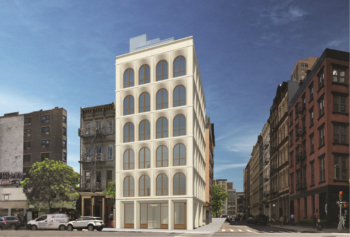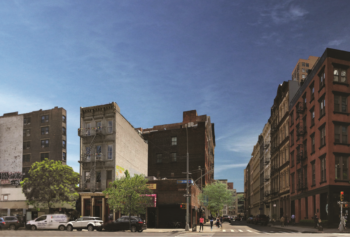
Rendering of proposed new building at 31 Lispenard Street/Image Credit: GF55 and Urban Standard Capital
Landmarks Preservation Commission had concerns with proposed building’s façade and bulkhead height. On September 17, 2019, the Landmarks Preservation Commission held a public hearing on a Certificate of Appropriateness to demolish an existing one and a half-story commercial brick building and construct a new seven-story mixed-used building with an elevated mechanical bulkhead at 31 Lispenard Street, Manhattan. The building is on the corner of Lispenard and Church Streets and located within the Tribeca East Historic District. Built in 1947 by Mac L. Reiser, the building was originally occupied by a garage and retail store but now houses a restaurant and a barbershop. The application was presented by Gregory Dietrich of Gregory Dietrich Preservation Consulting, David Gross of GF55 Architects, and Seth Weissman of Urban Standard Capital.

Existing building at 31 Lispenard Street./Image Credit: GF55 and Urban Standard Capital
The Tribeca East Historic District is predominately characterized by mid-19th to early 20th century style cast-iron and masonry buildings. North of the site on Church Street, there is a four-story mixed-use Italianate style grey brick building with a sandstone cast-iron storefront base and two brick commercial buildings at one- and two-stories. South of the site on Church Street, there are predominately four- and five-story Italianate and Second Empire style mixed-use buildings with brick and cast-iron façades and a cast-iron storefront base. On Lispenard Street, there are predominately five- to seven-story Renaissance Revival and Second Empire style mixed-use buildings. The buildings have brick, stone, and cast-iron façades and a cast-iron base. The façades are primarily red or buff but some have been painted cream or white. At the hearing, Richard Lowry, a Landmarks staffer, noted that the existing one and a half-story building was a “non-contributing” building in the district.
The new building will be seven-stories tall, rising to a height of 85 feet with an additional ten feet for its mechanical bulkhead. It will have ground-floor retail space and six floors of residential units, including a seventh floor penthouse. The proposed design is inspired by 41 White Street, 55 White Street, 52 Walker Street, and 361 Broadway, four sandstone cast-iron and stone Italianate and Second Empire style buildings with window bays spanning the façade and framed with quoins and pilasters. David Gross, the project’s architect, explained that the proposed design was to create a new, modern building that “takes the massing and geometry of the surrounding buildings.”
The proposed façade is made out of white pre-cast concrete and characterized by recessed, arched windows with copper-colored anodized metal mullions. The façade facing Church Street has four bays of windows at each story and the façade facing Lispenard Street has six bays of windows at each story. There is articulation between each bay and a horizontal band divides each story on the façade. A precast concrete cornice lines the top of the seventh floor and the building’s rear façade is made from off-white eifs cladding.
The base, which will house the retail space and the residential entrance, will be at a height of thirteen feet. The retail and residential entrances and the retail space windows would be setback into the base. The retail entrance will face Church Street and have a signage band on top. The retail space would wrap around the corner of the building, extending into Lispenard. The residential entrance will be on Lispenard Street and there would be a canopy above the entrance. The base’s façade, the retail signage band, and the canopy will be made with copper-colored anodized metal and the ground floor’s curb will be graphite granite.
At the top of the building, the seventh floor penthouse is set back at ten feet, the roof is set back at about 25 feet, and the bulkhead is set back at about 34 feet. The mechanical bulkhead, which will house the elevator mechanical room and stairway, will rise to a height of ten feet and will be made from off-white eifs cladding.
On June 25, 2019, Manhattan Community Board One voted to approve the application with the condition that the applicant reduce the height of the elevated bulkhead.
During public testimony, Brittney Thomas of the Historic Districts Council and Christabel Gough of the Society for the Architecture of the City had concerns that the building’s façade was too contrasting with the surrounding area and the historic district’s character. Thomas recommended that the applicant use a darker color for the façade. Thomas and Gough also had concerns about the height of the bulkhead.
The Commission generally believed that the demolition of the existing building was acceptable; however, a majority of the Commission had concerns about the building’s design and felt that the bulkhead’s height should be lowered.
Commissioner Michael Goldblum stated that the proposed design “lacks nuisance and delicacy” to make it fit in with its surroundings. He states that the proposed building lacks elements that are found in the four inspired buildings. Commissioner Goldblum explained that the proposed design lacks a sense of ascent such as diminishing the windows’ height as the building goes up and tiers of different articulation on the building and lacks traditional framing seen on the four buildings such as elaborated pilasters and quoins. He also recommended that the applicant use brick rather than eifs cladding for the rear façade.
Commissioner Diana Chapin noted that the building’s façade is more dominant than the façade of the inspired buildings. She stated that the building “shows more of its modernity than establishing dialogue with other buildings.”
The hearing was closed with the Commission taking no action on the application.
By: May Vutrapongvatana (May is the CityLaw Fellow and New York Law School Graduate, Class of 2019)

